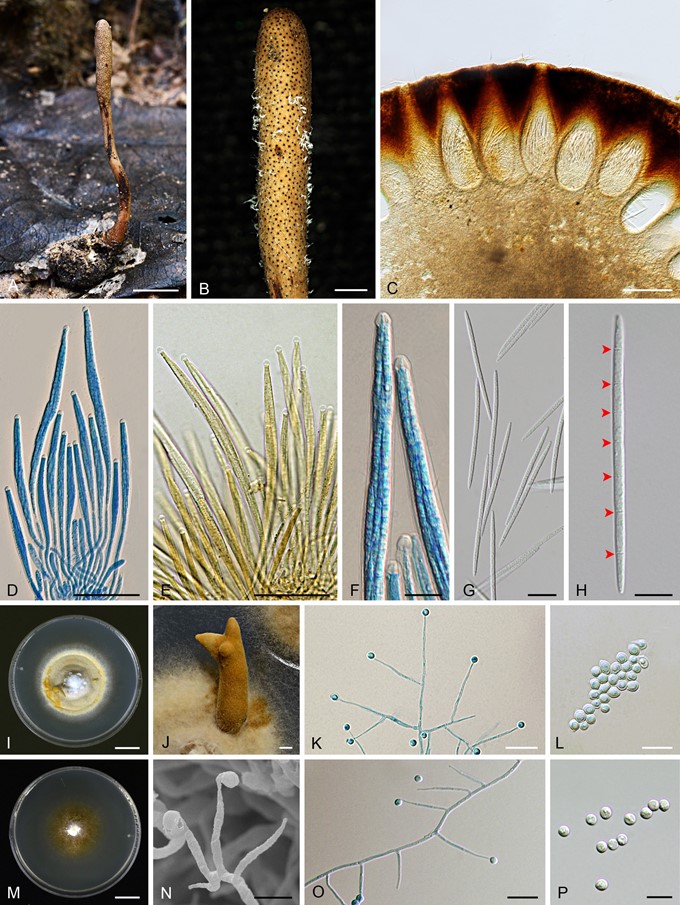Morakotia fusca Mongkolsamrit, Noisripoom, Khonsanit, Thanakitpipattana & Luangsa-ard, sp. nov.
MycoBank number: MB 838349; Index Fungorum number: IF 838349; Facesoffungi number: FoF; Fig. 3A–P.
Etymology: The specific epithet is from the Latin “fuscus”, referring to brown colour of fresh stromata.
Typus: Thailand, Phitsanulok Province, Ban Phaothai community forest, on seed (Smilacaceae), in leaf litter, 10 Oct. 2015, A. Khonsanit (AK), D. Thanakitpipattana (DT), S. Lamlertthon (SL), SM & W. Noisripoom (WN), MY 10972 (holotype BBH 41710, ex- type culture BCC 79272).
Stromata solitary or multiple, unbranched, tough, 20–75 mm long, 0.5–2 mm broad, cylindrical to enlarging apically, arising from the seed buried approximately 5–10 mm underground. Fertile part moderate orange yellow to brown orange (164A–164B), cylindrical to clavate, 5–20 mm long, 1.5–2.5 mm broad. Perithecia completely immersed, ordinal in arrangement, narrow flask-shaped, (320–)380–510(–570) × (120–)130–165(– 180) µm, ostioles darker reddish orange (175B). Asci cylindrical, 8-spored, (105–)160–240(–245) × (7–)8–9(–10) µm with caps 4–5 µm thick. Ascospores hyaline, whole, filiform, 7–8-septate, (70–)80–95(–105) × 2–4 µm. Colour change of stromata in 3 % KOH not observed.
Culture characteristics: Colonies on PDA attaining 30–35 mm diam in 30 d, cottony with high mycelial density, pale yellow (11C–D) to strong orange yellow (163B), reverse pale brown. Synnemata deep orange yellow (163A), 5–20 × 2–2.5 mm. Conidiogenous structures consisting of erect conidiophores arising from the vegetative hyphae. Conidiophores consist of verticillate phialides, singly or in whorls of two. Phialides awl- shaped, (20–)22–35(–40) × 1.5–2.5 µm. Conidia hyaline, globose, not in chains, (4–)4.5–5.5(–6) µm diam. Chlamydospores not observed.
Colonies on 2 % MEA attaining 20–25 mm diam in 30 d, cottony, white, scarce mycelial density, reverse brownish orange (N167B). Conidiogenous structures consisting of erect conidiophores arising from the vegetative hyphae or monophialidic arising along the hyphae. Conidiophores consist of verticillate phialides, singly or in whorls of two. Phialides awl-shaped, (20–)25–35(– 40) × (1–)1.5–2(–2.5) µm. Conidia hyaline, globose, singly not in chains, (4–)4.5–6 µm diam. Chlamydospores not observed.
Distribution: Found in the central and northeastern regions of Thailand.
Additional materials examined: Thailand, Phitsanulok Province, Ban Phaothai community forest, on seed (Smilacaceae), in the leaf litter, 10 Oct. 2015, AK, DT, SL, SM & W. Noisripoom (WN); MY 10973 (BBH 41711 paratype), ex-paratype culture BCC 79273, MY 10974 (BBH 41712), culture BCC 79274; idem., 4 Sep. 2016, SM, WN, R. Somnuk (RS), PS, KT, DT, S. Wongkanoun (SW), MY 11425 (BBH 41790), culture BCC 82798; Nakhon Ratchasima, Khao Yai National Park, on seed (Palmae), in the leaf litter, 24 Jun. 2012, AK, SM, WN, RS, PS & KT, MY 8554 (BBH 37585), culture BCC 64124, MY 8555 (BBH 37740) culture BCC 64125, idem., 26 Jun. 2012, AK, SM, WN, RS, PS & KT, MY 8624 (BBH 37745), culture BCC 64172.
Notes: Based on the natural specimen, Morakotia fusca is similar to Tolypocladium ophioglossoides in the colour and shape of its stromata. Both Morakotia fusca and T. ophioglossoides have brown orange and cylindrical stromata. However, Morakotia fusca differs from T. ophioglossoides on the basis of their hosts. Morakotia fusca occurs on seeds, whereas T. ophioglossoides occurs on truffles.

Fig. 3. Morakotia fusca (BBH 41710, BCC 79272). A. Stroma on seed. B. Fertile part of stroma. C. Immersed perithecia. D–F. Asci with asci caps. G, H. Whole ascospores with septations (arrows). I, J. Colony with synnema on PDA. K. Conidiophores consisting of verticillate phialides on PDA. L. Conidia on PDA. M. Colony on 2 % MEA. N, O. Conidiophores consisting of verticillate phialides on 2 % MEA. P. Conidia on 2 % MEA. Scale bars: I, M = 10 mm; A = 5 mm; B, J = 1 mm; C = 200 µm; D, E = 50 µm; G, K, O = 20 µm; F, H, L, N, P = 10 µm.
